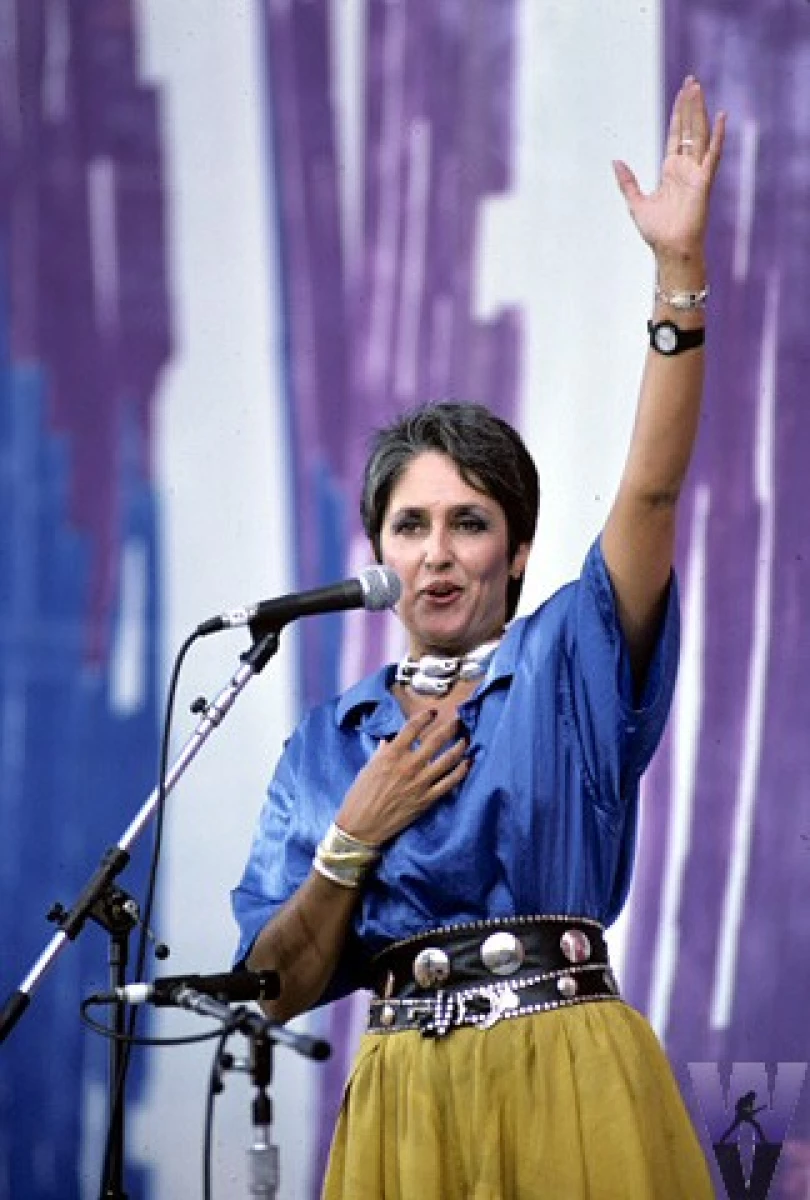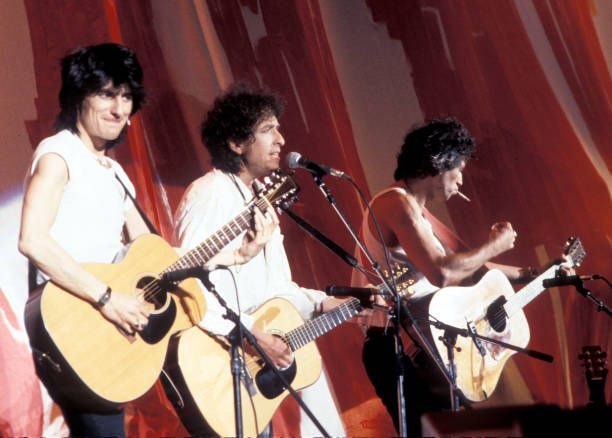July 13, 1985, 30 years ago: The Live Aid concerts are held: One at the old Wembley Stadium in West London, the other at John F. Kennedy Stadium in South Philadelphia.
The show was organized by Bob Geldof, leader of The Boomtown Rats; and James "Midge" Ure, lead singer of Ultravox. Geldof, Irish, and Ure, Scottish, had written "Do They Know It's Christmas?" for African famine relief, in time for the 1984 Christmas season, and got pretty much everybody who was currently anybody in music in the British Isles to sing on it.
With its success, an American version was inevitable. Producer Quincy Jones called Michael Jackson, at the time the biggest show business figure in the world. Jackson and Lionel Richie wrote "We Are the World," and Jones gathered several American musical luminaries to record it in Los Angeles. It was also a runaway success.
With both songs having raised a lot of money, a benefit concert was inevitable. It ended up being 2 shows, one in each country. It was a combination of current stars and established legends -- an "All-Star Game" and an "Old-Timers Day" in one. Or, in more recent parlance, an Avengers of rock and roll.
And it wasn't that easy. Geldof called Elton John, and said you gotta do it, because David Bowie and Queen had already agreed -- when they hadn't. While Elton was thinking it over, Geldof called Bowie, and told him that Elton and Queen had already agreed. Eventually, Geldof got everybody he wanted.
*
At 12:00 noon London time, 7:00 AM U.S. East Coast time, the British leg began at the original Wembley, England's national stadium since its opening in 1923. Holding 100,000 in its normal configuration, the huge stage limited it to 72,000 seats, all sold. Tickets were £5, plus a £20 donation to charity. With Britain's rate of inflation, that's about £75. With today's exchange rate, that's about $105.
The Coldstream Guards gave a royal salute, and played the National Anthem, "God Save the Queen." Queen Elizabeth II was not in attendance -- she was already 58 years old, and tolerated rock and roll more than actually enjoying it -- but her son and heir, Prince Charles, and his wife, Princess Diana, were there.
The Anthem done, the 1st band to play was Status Quo. They were followed by The Style Council, Geldof's Boomtown Rants, Adam Ant, Ure's Ultravox, Spandau Ballet, Elvis Costello (singing only one song, The Beatles' "All You Need Is Love"), Nik Kershaw, Sade (who may have the sexiest voice in all of humanity), Sting from The Police and Phil Collins from Genesis together, Howard Jones, Bryan Ferry, Paul Young, U2, Dire Straits, Queen, David Bowie, The Who reunited for the 1st time since their 1982 "farewell tour," and Elton John.
Queen came on at 6:41 PM, and have been widely regarded as the highlight of the Wembley part of the show. They played "Bohemian Rhapsody," "Radio Ga Ga" (the song that inspired Stefani Germanotta, born the next year, to rename herself Lady Gaga), "Hammer to Fall," "Crazy Little Thing Called Love," "We Will Rock You," and "We Are the Champions."
Freddie Mercury and Brian May of Queen
At 9:48, Queen's lead singer Freddie Mercury and lead guitarist Brian May came back out, and played, "Is This the World We Created?" At 9:51, former Beatle Paul McCartney came out, and, with Bowie, Geldof, Alison Moyet and Who guitarist Pete Townshend backing him, sang "Let It Be." At 9:57, the show closed with everybody coming back out, and, over 5 months before the next December 25, sang, "Do They Know It's Christmas?"
Left to right: Bob Geldof, Bono, Paul McCartney and Freddie Mercury
*
Built in 1926, as Sesquicentennial Stadium, for a world's fair celebrating the 150th Anniversary of American independence, and known from that fair until 1964 as Municipal Stadium, John F. Kennedy Stadium was a 105,000-seat horseshoe in South Philadelphia, with The Spectrum and then Veterans Stadium built adjacent. Best known as the site of the annual Army-Navy football game, it was, by this point, rarely used, since it was aging and not well-cared-for.
So, why there? The producer for the American leg was Bill Graham, already legendary for the concerts he promoted in San Francisco, and operator of the concert halls Fillmore West there and Fillmore East in New York. He got well-known TV producer Tony Verna to handle the U.S. broadcast. Verna was a Philadelphia native, and Verna was on good terms with Mayor Wilson Goode, who offered the use of JFK Stadium.
Why not New York? The biggest stadium in the Tri-State Area was Giants Stadium, and, this being before the building of the Meadowlands Spur of New Jersey Transit's rail operations, getting there by any means other than car was a miserable experience. (Given the inevitable traffic backups, getting there by car wasn't much better.) And since both Yankee Stadium and Shea Stadium were owned by New York City, they would have needed Mayor Ed Koch's permission to do the show at either one, and Koch wasn't interested.
Tickets were $35, or about $77 in today's money -- hardly an unreasonable price, given how many stars took the stage at JFK Stadium. The crowd was listed as 89,484. They started earlier, their time, than London did: 8:51 AM.
The 1st act was Bernard Watson. Who? His real name was David Weinstein, he was 18 years old, he was from Miami Beach, he had just graduated from high school, and he had no professional musical experience. He slept outside the stadium for a week, hoping to get a ticket, and ran into Graham, and talked him into letting him open. He sang Bob Dylan's "All I Really Want to Do," and a song he wrote, "Interview." (About the only information I have on him is that he's still alive.)
At 9:01 AM, Joan Baez, a veteran of the Greenwich Village folk scene, the Newport Folk Festival, and Woodstock took the stage. She told a generation too young to have gone to those shows, "This is your Woodstock, and it's long overdue." She sang "Amazing Grace" and "We Are the World."
She was followed by Philly natives The Hooters, then Motown legends the Four Tops. Trinidadian soul singer Billy Ocean was next, and then, a different style from any of those, the British inventors of heavy metal, Black Sabbath, with Ozzy Osbourne singing lead with them for the 1st time since 1979.
If that wasn't enough of a mix of styles, Sabbath were followed by the biggest group in rap at the time, Run-D.M.C. And they were followed by... Rick Springfield. And then REO Speedwagon. David Crosby, Stephen Stills and Graham Nash were the 2nd act from Woodstock, after Baez, to perform. And their soft-rock was followed by another British metal icon, Judas Priest. Then Bryan Adams. Then the Beach Boys, complete with Brian Wilson.
George Thorogood and the Destroyers came up from Delaware, with bluesmasters Bo Diddley and Albert Collins sitting in. Simple Minds came over from Scotland. The Pretenders were next. At the time, their leader, Chrissie Hynde, was married to Simple Minds' leader, Jim Kerr. Then, Woodstock veterans Santana. Motown songwriting couple Nick Ashford & Valerie Simpson, by now singing their own songs, performed with Philly native Teddy Pendergrass, by then in a wheelchair following a car crash.
Madonna was next, with Thompson Twins and Nile Rodgers backing her. Then, Tom Petty and the Heartbreakers, Kenny Loggins, The Cars. Neil Young, who has often performed with Crosby, Stills and Nash, performed without them. Next up was The Power Station: Lead singer Robert Palmer; Duran Duran guitarist Andy Taylor and bassist John Taylor; and Chic drummer Tony Thompson. Then, Eric Clapton.
One man played at Wembley, got over to Heathrow Airport, flew across the Atlantic Ocean on the Concorde, got from JFK Airport in New York by helicopter to JFK Stadium in Philadelphia, and played there, too: Phil Collins. He had played from 3:18 to 3:48 in London, and from 8:00 to 8:35 in Philadelphia -- with the 5-hour time difference, it was about a 10-hour gap.
And that may not have been the most notable thing he did that day. He played drums for Led Zeppelin. Singer Robert Plant, guitarist Jimmy Page and bassist John Paul Jones hadn't played together since drummer John Bonham died in 1980. But, with Collins sitting in, they played "Rock and Roll," "Whole Lotta Love" and "Stairway to Heaven."
Then, as night began to fall over the Delaware Valley, Crosby, Stills, Nash & Young did sing together. So did Duran Duran. Then things got serious: On came Philly native Patti LaBelle. Then Philly natives Daryl Hall & John Oates, with former Temptations singers Eddie Kendricks and David Ruffin.
Tina & Mick
At 10:15, Mick Jagger of the Rolling Stones and Tina Turner took the stage, and sang 5 songs together. At 10:39, backed by Stones guitarists Keith Richards and Ron Wood, Bob Dylan, who did not play at Woodstock, came on, and sang "Ballad of Hollis Brown," "When the Ship Comes In," and "Blowin' in the Wind." The finale, at 10:55, was everybody coming onstage to sing "We Are the World."
Between the 2 shows, it was estimated that 1.9 billion people watched at least part of the broadcast, about 40 percent of the world's population at the time. Money raised? According to Geldof, about £150 million, or about $107 million given what was then the exchange rate, or about $235 million in 2015 money.
This was the greatest thing ever to happen at Wembley, or any other sports stadium. England's victory in the 1966 World Cup Final is a distant 2nd.
The old Wembley was not well-cared-for, and a replacement became necessary. It was closed in 2000, demolished, and the new Wembley Stadium opened on the site in 2007.
Mick and the Stones had planned to return to JFK Stadium for their Steel Wheels tour in 1989, but it was ruled unsafe for occupancy, so they headed 2 blocks north to The Vet. The last show at JFK Stadium was The Grateful Dead in 1991. The following year, it was demolished. In 1996, the new arena for the NBA's Philadelphia 76ers and the NHL's Philadelphia Flyers opened on the site. As one bank has bought out another, arena naming rights and all, it has gone through several names, and is currently the Wells Fargo Center.










No comments:
Post a Comment